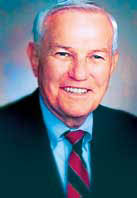 This December 17th, powered flight will be 100 years old. That day, in 1903, Orville and Wilbur Wright first flew their “Wright Flyer” at Kitty Hawk, N.C.
This December 17th, powered flight will be 100 years old. That day, in 1903, Orville and Wilbur Wright first flew their “Wright Flyer” at Kitty Hawk, N.C.
Orville was the first pilot. He flew 120 feet in 12 seconds. The brothers from Ohio made three more flights that day, and on the last flight, Wilbur flew 852 feet in 59 seconds. Progress had already been made.
Because of my background in aviation, this date has always been of interest to me and got me thinking about progress in business. Progress in aviation is pretty plain for all to see, from the Wright brothers through WWI and WWII airplanes and the jets of more recent vintage. A similar type of progress opens up great opportunities in the selling business as well.
There has been much progress in the sanitary supply business over the years. But, progress opens the door only to those salespeople alert enough to keep current on progress.
The old adages, “Leave well enough alone” and, “If it ain’t broke, don’t fix it,” will put you out of business sooner than later. Imagine if people had said that when it came to the Wright Flyer. A few tried; in fact, the U.S. military was very slow in acknowledging the huge benefits brought by aviation. It took Britain and Germany to get their attention.
How about you as a manufacturer, a distributor owner, manufacturer’s rep or a sales rep: do you want to leave well enough alone? If so, look out; someone will soon be “eating your lunch.”
“If it ain’t broke — break it anyway” is the motto that will take you to the next level of success.
It is easy to sit back with a great-selling widget and think you’re “king of the hill.” Just look out: somewhere, someone is working on an idea that will dethrone the king.
Let’s look at some industry pioneers who aided in industry progress: Sweeping started by using a broom made of some type of material because it was a necessity — cavemen had to sweep out their caves. Then along came Mr. Bissell who invented the carpet sweeper. Then came along a custodian by the name of James Spangler who, from a fan, a pillowcase and an electric cord, crafted the first electric vacuum cleaner. He joined forces with a man named Hoover, and the rest, as they say, is history. Today, two-motor uprights, wide-area vacuums, and ride-on sweeper/vacuums create opportunities for the sellers that are worth millions.
In the early 1960s, the development of synthetic floor finishes really put the “floor wax” sellers out of business. Floor waxes were soft and required constant buffing to keep them looking shiny. Floor finishes were “self polishing” and quite scuff-resistant. Then floor pads were invented. They were used under floor machines in place of brushes and steel wool pads. 3M introduced the first pads. They had one working side with an adhesive on the other and were used under a floor machine brush. Not much after, 3M and then others developed pad holders and two-sided pads (thin). Then the thick pad came along, creating an inventory headache. Sizes from 12 inches to 22 inches, thick and thin, each in three or four colors. Pads increased productivity and led to spray buffing when using synthetic floor finishes. All floor machines of that era turned at 175 revolutions per minute (rpm) and spray buffing greatly increased the time between stripping floors. Of course, at that time we were all concerned that spray buffing would reduce our sale of floor finish products. It didn’t, and it was a vast improvement — more progress.
It was discovered that a 300-rpm machine would cut spray-buffing time by 40 to 50 percent, so they were were introduced. Then someone thought a two-speed 175/30-rpm machine would make more sense than having to buy two units.
Then came the electric burnisher, which turned at approximately 1,000 to 1,500 rpm. A gentleman by the name of Bill Wilson took that burnisher and a system of floor care products to go along with it and built a company called Pioneer Eclipse. Bill Wilson and his burnishing idea created a whole new way of floor maintenance.
Today the electric burnisher is still in use in many areas and most manufacturers have added battery and propane units to their line — more progress and more selling opportunities.
The floor finishes and the floor pads of that day were not suited for 1,000 to 2,500-rpm machines. The floor finish abraded off the floor and the pads blew apart. The floor finish and floor pad manufacturers had to go back to their drawing boards and develop different and better products to fit this new technique.
These examples illustrate how product innovation is progress, constantly creating new items and giving salespeople better opportunities to sell.
There has been much more progress over the years in the janitorial supply business. In next month’s article, we will look at some other innovations that shaped the jan/san industry.
To share your selling ideas, fax: (414) 228-1134, contact Mr. Dixon at (877) 379-3566 or e-mail.
 Cleaning: Business & Industry
Cleaning: Business & Industry
Progress Pays Big Dividends
BY Maurice Dixon
POSTED ON: 6/1/2003

 The Down and Dirty on Cleaning in Virus Season
The Down and Dirty on Cleaning in Virus Season How Surfactant Use is Expanding in Commercial Cleaning
How Surfactant Use is Expanding in Commercial Cleaning Operational Excellence Series 2025: Better Budgeting
Operational Excellence Series 2025: Better Budgeting